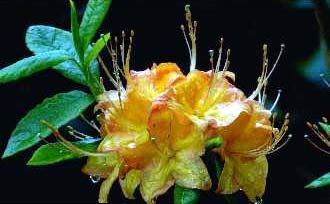| |
NUTRIENT DEFICIENCIES IN PLANTS
|
| |
Fungal disease and insects are not the only causes of growth disturbances in plants. Much damage is done to plants by the absence of important nutrients in the soil.
Plants are less apt to be deficient in nutrients today than they were 100 years ago. Modern analytical methods provide information about the soil, and experience in plant cultivation has taught horticulturists what demands are made on soil by vegetables, berry bushes, and garden flowers.
Underfed or Overfed?
Oddly enough, in most gardens, plant diseases are more likely to result from excessive fertilizing than from under-fertilizing. Over-supplies of nitrogen and phosphate are most frequently encountered. Some plants, like fruit trees, tomatoes, and cabbage, create problems because they absorb certain nutrients from the soil in especially large amounts that normal fertilizing alone does not always provide. The result is that the nutrient deficiency causes visible signs and symptoms of disease.
Less Is Better
Every nutrient element performs a unique function in plant metabolism, and none can be replaced by an excess of another nutrient. Thus, a potassium deficiency can be corrected only by a potassium supplement, such as wood ash. An added feeding of nitrogen for the same plant would have no effect whatsoever. The absence of a single nutrient seriously compromises the overall metabolism of the plant. Critical growth and development disturbances are the result. Yellowing (chlorosis) and browning of leaves, stunted growth, premature loss of fruit, and diminished resistance to frost are among the most frequent signs and symptoms.
Potassium Deficiency in Fruit
If nutrient deficiencies do occur, they generally strike fruit trees with the greatest force. Apples, cherries, and berry plants have high requirements for potassium and magnesium.
Potassium is instrumental in the orderly distribution of water throughout the leaves. Plants also need potassium for metabolism and growth. If potassium is lacking, leaves remain small; they finally turn brown from the edges inward and die. As they continue to shrivel, they hang limply on branches.
A deficiency of potassium can also occur when a tree sets too much fruit. All apples absorb great amounts of potassium during their maturation, and they draw it in from many branches and leaves. If the soil is unable to replace all the potassium that the developing fruit has absorbed from the branches and leaves, the tree soon becomes undernourished. This is an important reason why fruit trees should be thinned in early summer before they set too much fruit.
Magnesium Deficiency
Plants need magnesium to form chlorophyll, the basis of all growth. Magnesium also plays a crucial role in many metabolic enzyme reactions. The symptoms of a magnesium deficiency are similar to those of a potassium deficiency, except that leaves turn brown from the center outward toward the edges. Leaf nerves remain green. Unlike a potassium deficiency, a magnesium deficiency causes diseased leaves to drop prematurely. Potatoes, cucumbers, and tomatoes frequently suffer from magnesium deficiency.
With all crops, an acute magnesium deficiency can be corrected by amending the soil with dolomitic lime, which is a mixture of magnesium and calcium carbonate. But be careful: an excess of magnesium will prevent plants from absorbing potassium.
TIPS: Routine Soil Analyses
It is often easy to diagnose just what nutrient is deficient in the soil simply from the external symptoms. But only a soil analysis can provide definite information. It is a good practice to have your soil analyzed routinely once every 5 years. Armed with the information such analysis will provide, you will be able to correct the deficiencies
THE MOST IMPORTANT SYMPTOMS OF DISEASE AT A
GLANCE
|
Deficient nutrient |
Where symptoms first
occur |
What ailing plants look
like |
|
Nitrogen (N) |
Old leaves |
Growth is stunned, plants
are bright green, leaf tips turn brown. |
|
Phosphorus (P) |
Old leaves |
Plants feel strangely
brittle; leaves turn dark green, later reddish to
bronze. |
|
Potassium (K) |
Old leaves |
Leaves turn yellow at the
edges then brown all over; they remain small, and hang
limply from branches. |
|
Sulfur (S) |
Young leaves |
Leaves turn bright green,
later yellow or reddish; plants look brittle. |
|
Magnesium (Mg) |
Old leaves |
Bright spots appear on
leaves; leaves finally turn yellow except that ribs
remain green. |
|
Calcium (Ca) |
Young leaves |
Growth is stunted; young
leaves turn yellow, older leaves remain dark green;
upper stems buckle and snap. |
|
Iron (Fe) |
Young leaves |
Leaves turn bright yellow
or white; healthy leaf veins remain green. |
|
Manganese (Mn) |
Young leaves |
Brownish decaying spots
appear; leaf veins stay green; leaves dry and then snap. |
|
Boron (B) |
Young leaves |
Leaf stalks brighten, turn
brown, and die; plants are stunted, dying from the tips. |
|
Zinc (Zn) |
Old leaves |
Dark stripes appear along
principal leaf veins; leaf surfaces lighten or become
white; in apples, leaves become rosette-shaped |
|
Copper (Cu) |
Young leaves |
Shoot tips die, terminal
leaves turn brown then drop; leaves may fail to develop. |
|
|
|


